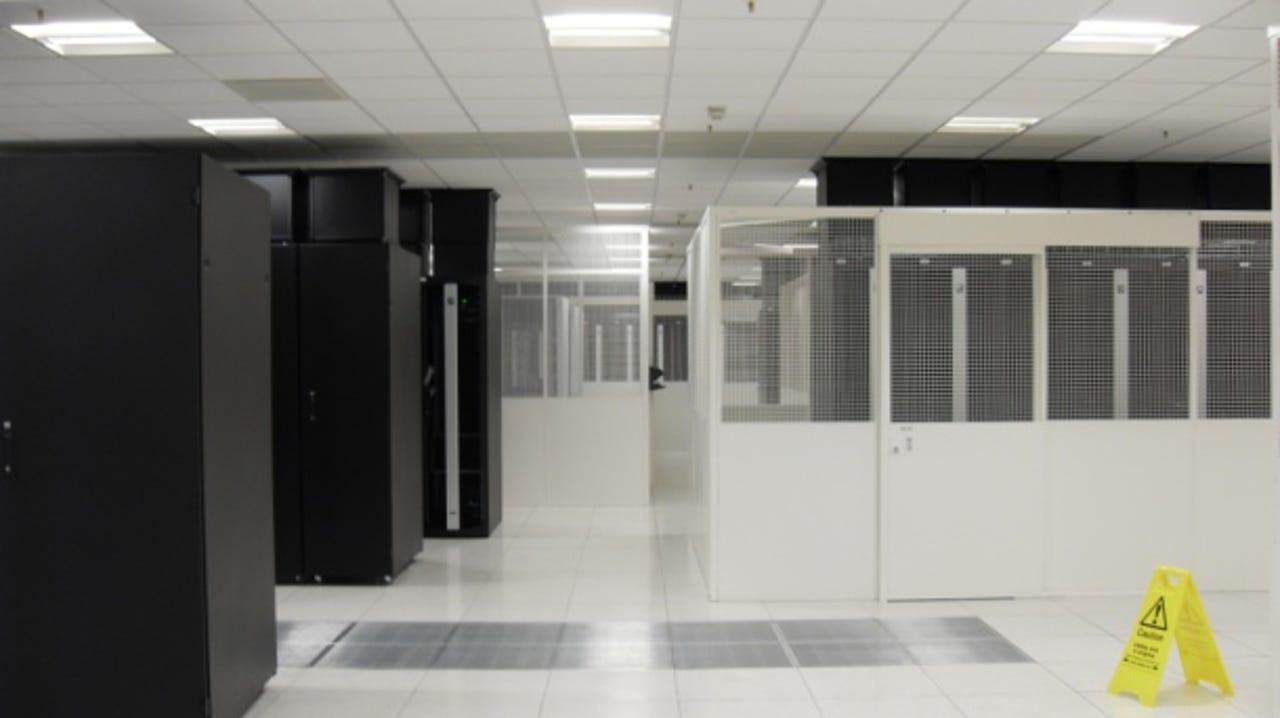Inside Telecity's co-location datacentre


Telecity Powergate datacentre
TelecityGroup's three-year-old Powergate co-location facility in west London is in the middle of an expansion that will see its IT floor space triple.
Powergate is used as a spillover capacity site for data from Telecity's five Docklands-based and two City-based datacentres. The facility has a power usage effectiveness (PUE) rating of around 1.65. As a co-location provider, Telecity is not able to choose the hardware in the facility, but it has some control over how it can increase energy efficiency.
It offers varying levels of security to companies, ranging from open racks (left) to cages (centre back) to cages with biometric and/or password protection (right). Because of this, it cannot easily arrange the racks into regimented designs, as used in facilities run by sole providers such as Rackspace's UK cloud datacentre.
What it can do, however, is put shells around the racks with in-built chimneys to conduct the hot air up and as far away from the computer room air-conditioning (Crac) cooling units as possible. Maximising the distance from the hot air and the cold air boosts the efficiencies of the cooling systems, according to Telecity.
The problems of heat will grow over time, Rob Coupland, Telecity's chief operating officer, believes. He told ZDNet UK that in five or six years' time, he expects datacentre companies will have to find ways to deal with a higher amount of electricity per rack, as servers grow ever more intensive in power consumption, driven by more and more processors fitting into each server.
See more of ZDNet UK’s datacentre tour.
Server-simulators
To get a picture of how the datacentre consumes power day-by-day, Telecity has hundreds of server-simulators (pictured) available that it uses to mimic the expected power load. This helps them find kinks in their power distribution systems before customers put their racks in. The modelling lets Telecity stress-test the power systems' response to demand spikes and expected loads.
See more of ZDNet UK’s datacentre tour.
Data hall in construction
The company is tripling the size of the facility with a new set of 12 data halls. The new building will be built using more modern techniques, which are expected to increase the power efficiency of the overall site.
The data halls will come online in three stages, with four going live at a time. Each hall will have its own generator and power distribution systems for added redundancy. Telecity could not say when the work will be complete.
See more of ZDNet UK’s datacentre tour.
Transformer
As with all datacentres, provisioning the extra power to the site was a challenge. Originally, Telecity ordered 24MVA of power capacity from utility Scottish and Southern Energy, which has a distribution station around a mile away from the facility's north Acton site. This proved to be difficult, so it changed the order to 60MVA, which was a large enough order for the utility to agree to construct a substation and transformer (pictured) onsite.
Because a National Grid distribution point is around 150 metres away from the substation, less power is lost between the two during transmission. The power supply was one of Telecity's main considerations when choosing the site for Powergate.
Coupland explained that the co-location provider is in talks with energy suppliers to know "where they are in terms of grid capacity", so they can together plan future datacentres.
See more of ZDNet UK’s datacentre tour.
Artist's impression of the datacentre
When completed, the expanded facility will have an additional 21MW of IT power at its disposal and over 100,000 additional square feet of IT space, according to Telecity.
The old data halls and the new ones will be linked by an overhead walkway (pictured). The company hopes to move the PUE down from 1.65 to 1.35 by tweaking the overall design.
Get the latest technology news and analysis, blogs and reviews delivered directly to your inbox with ZDNet UK's newsletters.